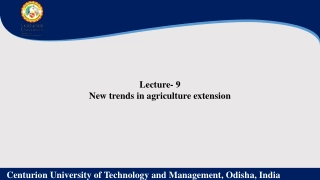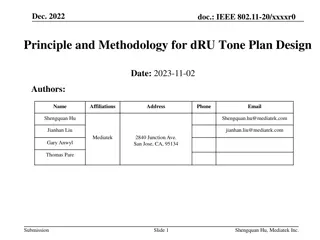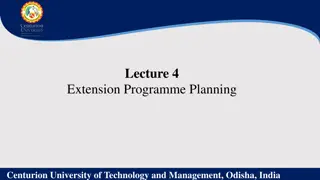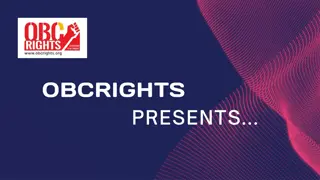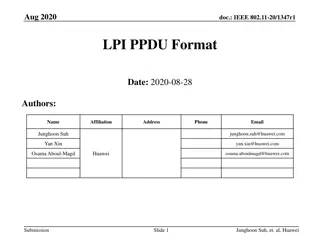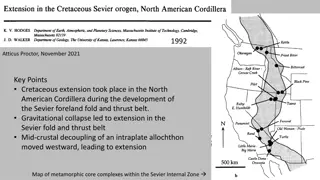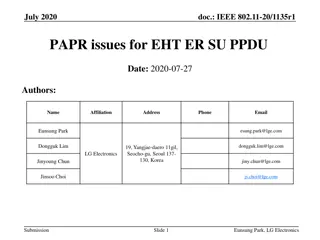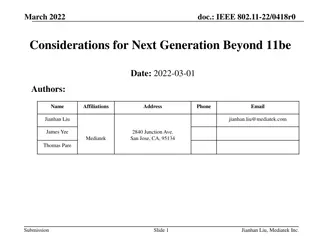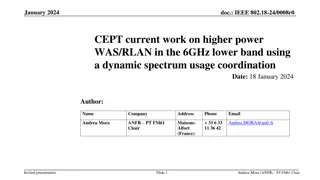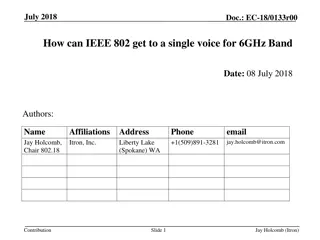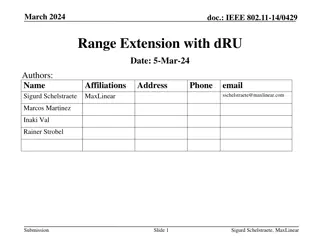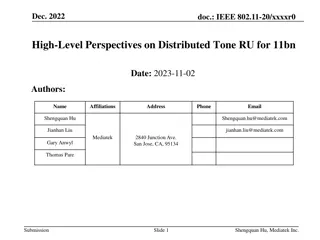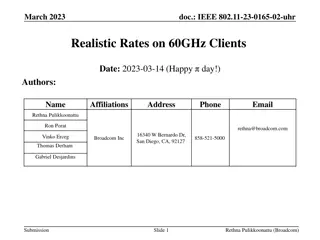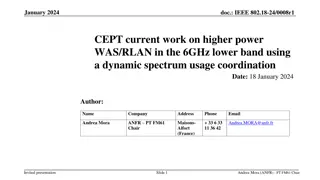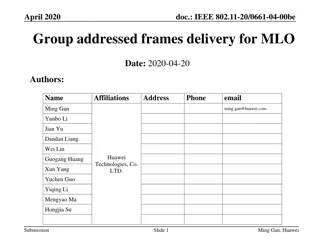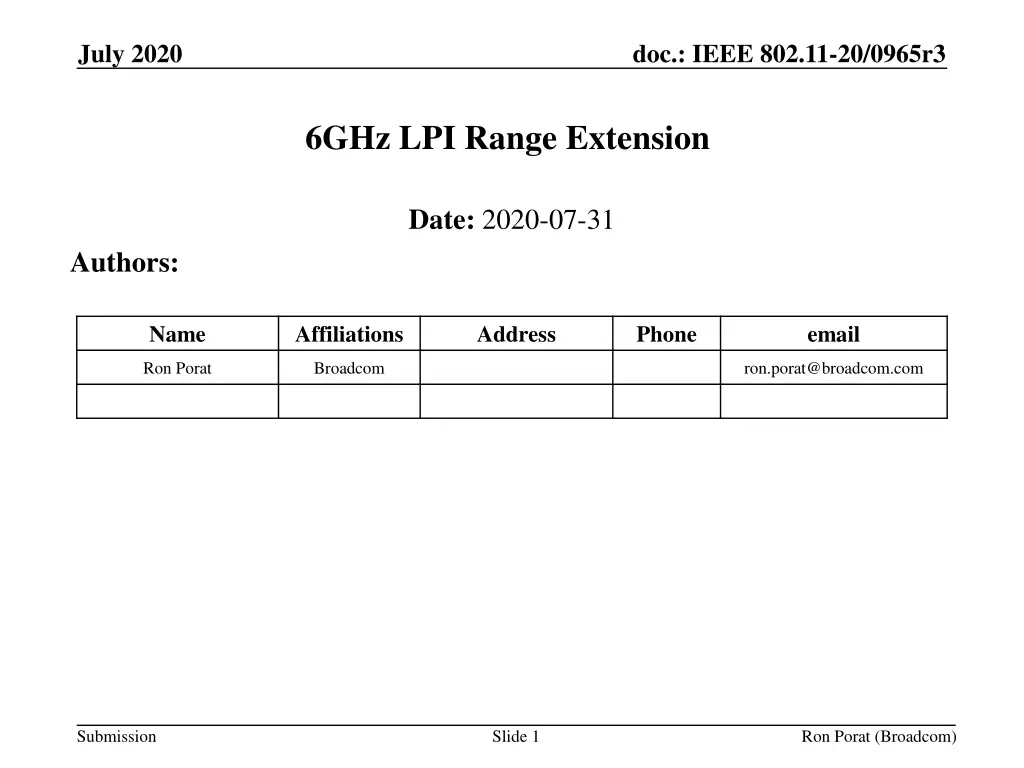
IEEE 802.11-20/0965r3 LPI Range Extension Proposal
Explore the proposal for lower rate SU modes to enhance the DL and UL range over 11ax design in the context of the newly approved 1.2GHz spectrum for unlicensed use in the US under LPI rules. The idea is to define DUP modes for specific transmission sizes to achieve improved range and maximize the transmission power within the available bandwidth.
Download Presentation

Please find below an Image/Link to download the presentation.
The content on the website is provided AS IS for your information and personal use only. It may not be sold, licensed, or shared on other websites without obtaining consent from the author. If you encounter any issues during the download, it is possible that the publisher has removed the file from their server.
You are allowed to download the files provided on this website for personal or commercial use, subject to the condition that they are used lawfully. All files are the property of their respective owners.
The content on the website is provided AS IS for your information and personal use only. It may not be sold, licensed, or shared on other websites without obtaining consent from the author.
E N D
Presentation Transcript
July 2020 doc.: IEEE 802.11-20/0965r3 6GHz LPI Range Extension Date: 2020-07-31 Authors: Name Affiliations Address Phone email Ron Porat Broadcom ron.porat@broadcom.com Submission Slide 1 Ron Porat (Broadcom)
July 2020 doc.: IEEE 802.11-20/0965r3 Abstract In the US, 1.2GHz is now approved for unlicensed use under low power indoor (LPI) rules. This provides a huge boost (3x) to the spectrum available to 11be and 11ax devices although at a reduced power and PSD 5dBm/MHz for AP and -1dBm/MHz for STA. Hence, we propose to define one lower rate SU mode to improve DL and UL range over the 11ax design Revision r3 added SP based on discussion on the call Submission Slide 2 Ron Porat (Broadcom)
July 2020 doc.: IEEE 802.11-20/0965r3 Max LPI Power and 11ax Rates It is desirable by AP and STA to use the maximum available BW in the BSS in order to maximize the transmission power Dropping BW doesn t provide better SNR prefer to maintain BW while lowering rates Tx BW [MHz] Max Power AP EIRP [dBm] 18 21 24 27 30 Lowest rate in 11ax [Mbps] 0.8uS GI with DCM 4.3 8.6 18 36 - 20 40 80 160 320 Tx BW [MHz] Max Power STA EIRP [dBm] 12 15 18 21 24 Lowest rate in 11ax [Mbps] 0.8uS GI with DCM 4.3 8.6 18 36 - 20 40 80 160 320 Submission Slide 3 Ron Porat (Broadcom)
July 2020 doc.: IEEE 802.11-20/0965r3 Proposal For SU80, SU160 and SU320 transmissions define a DUP mode of SU40, SU80 and SU160 limited to MCS0+DCM @Nss=1 to generate lower rates For SU20 and SU40 11ax rates are quite low already and we don t see the need to define lower rates E.g., 160MHz rates > 160 MCS0 (72Mbps) 160 MCS0+DCM (36Mbps) 160 (80MHz MCS0+DCM) + DUP (18Mbps) Note we assume MCS0+DCM will be defined in 11be , see also [1] Beacons can already be sent in Non-HT DUP mode in 11ax @6GHz 80MHz-wide beacons provide range extension for STA that combine the four repetitions. Submission Slide 4 Ron Porat (Broadcom)
July 2020 doc.: IEEE 802.11-20/0965r3 Summary Lower SU rate using DUP design is proposed for 11be for improved range of the new LPI spectrum. Submission Slide 5 Ron Porat (Broadcom)
July 2020 doc.: IEEE 802.11-20/0965r3 References [1] 20/0986 DCM for range extension in 6GHz LPI Submission Slide 6 Ron Porat (Broadcom)
July 2020 doc.: IEEE 802.11-20/0965r3 SP #1 Do you agree to define a DUP mode for non-punctured 80MHz, 160MHz and 320MHz PPDUs transmitted to a single user, limited to {MCS0+DCM, Nss=1}? 80 DUP = 40 duplicated 160 DUP = 80 duplicated 320 DUP = 160 duplicated PAPR reduction scheme is TBD For rel. 1 Submission Slide 7 Ron Porat (Broadcom)
July 2020 doc.: IEEE 802.11-20/0965r3 SP #2 Do you agree that duplication in the mode defined in SP #1 is done only on the data tones of the payload portion and that EHT-STF/LTF are based on the total BW? For 80MHz the 80MHz OFDMA LTF sequence is used For 160/320MHz the non-OFDMA 160/320 LTF sequence is used Pilots are the same as pilots for the non-DUP mode of the same BW and using OFDMA tone plan for 80MHz Non-OFDMA tone plan for 160/320MHz Submission Slide 8 Ron Porat (Broadcom)
July 2020 doc.: IEEE 802.11-20/0965r3 SP #3 Do you agree that the mode defined in SP #1 is limited to 6GHz? Submission Slide 9 Ron Porat (Broadcom)

